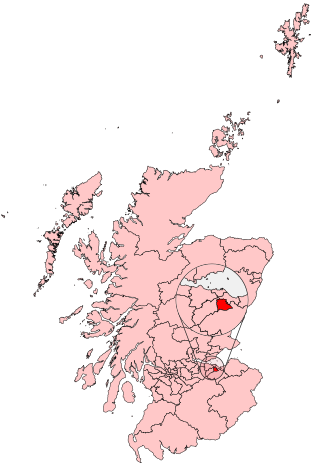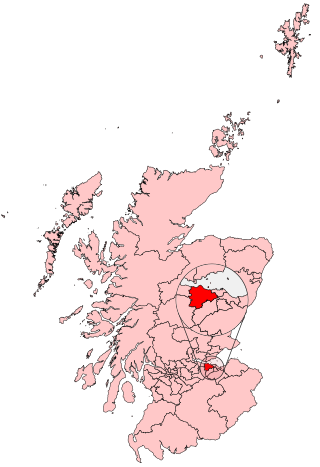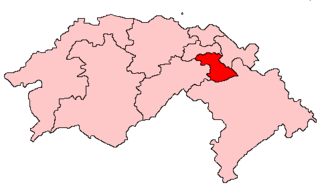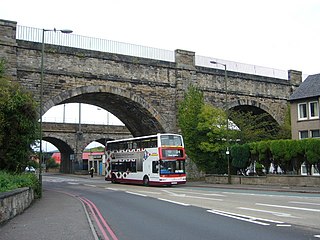Boundaries
1950–1955: The Colinton, Gorgie-Dalry, Merchiston and Sighthill wards of the county of the city of Edinburgh. [1]
1955–1974: The Colinton, Merchiston and Sighthill wards of the county of the city of Edinburgh, and part of the Gorgie-Dalry ward. [2]
1974–1983: The Colinton and Sighthill wards of the county of the city of Edinburgh, and part of the Merchiston ward. [3]
1983–1997: Electoral divisions 10 (Balerno/Baberton), 24 (Hailes), 25 (Sighthill/Longstone), 35 (Colinton/Firrhill) and 36 (Braidburn/Fairmilehead) in the City of Edinburgh. [4]
1997–2005: Electoral divisions 10 (Balerno/Baberton), 22 (Longstone/Craiglockhart), 30 (Sighthill/Broomhouse), 31 (Colinton/Firrhill), and 35 (Braidburn/Fairmilehead) in the City of Edinburgh. [5]
In 2005, prior to the general election, the Westminster constituency was one of six covering the City of Edinburgh council area. Five were entirely within the city council area. One, Edinburgh East and Musselburgh, straddled the boundary with the East Lothian council area, to take in Musselburgh. Edinburgh Pentlands covered a south-western portion of the city council area.
In terms of wards used for elections to the City of Edinburgh Council, 1999 to 2007, Edinburgh Pentlands included wards named Balerno, Baberton, Colinton, Craiglockhart, Fairmilehead, Firrhill, Murrayburn, Parkhead, and Sighthill. The South Morningside ward was split between Edinburgh Pentlands and Edinburgh South. The seat had an urban north and a suburban centre. The remaining area was rural, and included a Pentland Hills area in the south.
In 2005, most of the constituency became part of Edinburgh South West. The Fairmilehead and South Morningside wards went to Edinburgh South. For the 2005 election, there were five constituencies covering the city area, all entirely within that area. [6]

Midlothian is a historic county, registration county, lieutenancy area and one of 32 council areas of Scotland used for local government. Midlothian lies in the east-central Lowlands, bordering the City of Edinburgh council area, East Lothian and the Scottish Borders.

Edinburgh South is a constituency of the House of Commons of the UK Parliament created in 1885. The constituency has been held by Scottish Labour since 1987. The seat has been represented since 2010 by Ian Murray, who currently serves as Secretary of State for Scotland under the government of Keir Starmer. Murray was the only Labour MP in Scotland to retain his seat at the 2015 and 2019 general elections and this is one of only three seats never held by the Scottish National Party (SNP).

Edinburgh West is a burgh constituency of the House of Commons of the Parliament of the United Kingdom, first contested at the 1885 general election.

Edinburgh Pentlands is a constituency of the Scottish Parliament (Holyrood) covering part of the council area of Edinburgh. It elects one Member of the Scottish Parliament (MSP) by the plurality method of election. It is one of nine constituencies in the Lothian electoral region, which elects seven additional members, in addition to the nine constituency MSPs, to produce a form of proportional representation for the region as a whole.

Edinburgh South West is a Scottish constituency of the House of Commons of the Parliament of the United Kingdom, first used at the 2005 UK general election. It elects one Member of Parliament (MP) by the first past the post system of election. Since 2024, it has been represented by Scott Arthur of the Labour Party.

Edinburgh South was a constituency of the Scottish Parliament (Holyrood). It elected one Member of the Scottish Parliament (MSP) by the plurality method of election. Also, however, it was one of nine constituencies in the Lothians electoral region, which elected seven additional members, in addition to nine constituency MSPs, to produce a form of proportional representation for the region as a whole.

Edinburgh Central was a burgh constituency of the House of Commons of the Parliament of the United Kingdom from 1885 to 2005. It elected one Member of Parliament (MP) by the first past the post system of election.

Edinburgh Central is a burgh constituency of the Scottish Parliament (Holyrood) covering part of the council area of Edinburgh. It elects one Member of the Scottish Parliament (MSP) by the plurality method of election. It is also one of nine constituencies in the Lothian electoral region, which elects seven additional members, in addition to the nine constituency MSPs, to produce a form of proportional representation for the region as a whole.

Colinton is a suburb of Edinburgh, Scotland situated 3+1⁄2 miles southwest of the city centre. Up until the late 18th century it appears on maps as Collington. It is bordered by Dreghorn to the south and Craiglockhart to the north-east. To the north-west it extends to Lanark Road and to the south-west to the City Bypass. Bonaly is a subsection of the area on its southern side.

Juniper Green is a village on the outskirts of Edinburgh, Scotland, situated about 5.5 miles (8.9 km) south-west of the city centre. It bridges the city bypass, and extends along the foothills of the Pentlands. It is bordered by Colinton to the east, Baberton immediately to the north, and Currie to the south-west. It centres on Lanark Road, the main route leading out south-west of Edinburgh into the Central Borders. The village stands on an elevated ridge above the Water of Leith to its south.
Sighthill is a suburb in the west of Edinburgh, Scotland. The area is bordered by Broomhouse and Parkhead to the east, South Gyle to the north, the industrial suburb of Bankhead and the Calders neighbourhood to the west, and Wester Hailes to the south. It is sometimes included in the Wester Hailes area, while the Calders, Bankhead and Parkhead are sometimes considered parts of Sighthill. Administratively it has formed a core part of the City of Edinburgh Council's Sighthill/Gorgie ward since 2007.

Longstone is a suburb of Edinburgh in Scotland. The area is primarily residential in nature, although the area includes several small shops, eateries and supermarkets, as well as one of the main bus depots for the city's buses. The population of Longstone was 4,678 in 2019.
Edinburgh, the capital of Scotland, is traditionally said to have been "built on Seven Hills", in an allusion to the seven hills of Rome. While there is considerable room for debate as to which hills are included and excluded from the seven, seven possibilities are listed in an old rhyme:
Parkhead is a residential area of Edinburgh, the capital of Scotland. It was one of the smallest wards in the Edinburgh City Council before a reorganisation into larger multi-member wards in 2007; since then it has been part of the Sighthill/Gorgie ward.

Edinburgh Southern is a constituency of the Scottish Parliament (Holyrood) covering part of the council area of Edinburgh. It elects one Member of the Scottish Parliament (MSP) by the plurality method of election. It is one of nine constituencies in the Lothian electoral region, which elects seven additional members, in addition to the nine constituency MSPs, to produce a form of proportional representation for the region as a whole.

The City of Edinburgh Council is the local government authority covering the City of Edinburgh council area. Almost half of the council area is the area of Edinburgh, capital of Scotland. With a population of 514,990 in mid-2019, it is the second most populous local authority area in Scotland.

Sighthill/Gorgie is one of the seventeen wards used to elect members of the City of Edinburgh Council, established in 2007 along with the other wards. Its territory comprises a corridor of land in the west of the city with a northern boundary formed by the railway lines between the Haymarket and Edinburgh Park stations, encompassing the Broomhouse, Dalry, Gorgie, Longstone, Parkhead, Saughton, Sighthill and Stenhouse neighbourhoods. It elects four Councillors. In 2019, the ward had a population of 33,826.

Elections to the City of Edinburgh Council took place on 5 May 2022 on the same day as the 31 other Scottish local government elections. As with other Scottish council elections, it was held using single transferable vote (STV) – a form of proportional representation – in which multiple candidates are elected in each ward and voters rank candidates in order of preference.














